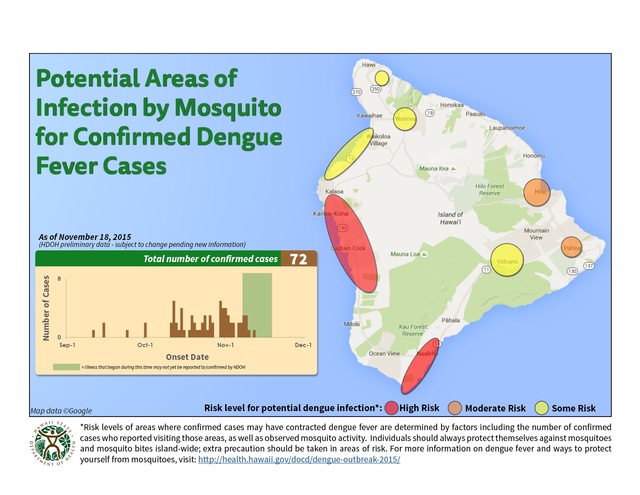“We’re at the beginning of a marathon.”
That’s how State Epidemiologist Dr. Sarah Park described the current dengue fever outbreak on Hawaii Island when asked how long it could take to contain the mosquito-borne virus.
With the number of confirmed cases climbing to 79 Thursday, it appeared at the recent rate, the Big Island outbreak could surpass the 2001 Maui outbreak in size and scope within a week or two. The 2001 outbreak saw a total of 92 cases on Maui.
But during a noon press conference with Gov. David Ige, Park said the state now is focusing less on numbers as it continues the investigation into the spread of the dengue virus.
“The actual numbers, the rising, the falling … The number itself is not as important for the (epidemiologic) investigation, so much as the pattern of how those cases occur,” she said. “… Now, we actually have more data. … Now, we have enough cases that we’re starting to see patterns, and that’s really very useful to the investigation.”
On Wednesday afternoon, the state Department of Health revealed a new version of a map showing the Big Island and the areas were the dengue virus likely is to have been transmitted to people from mosquitoes.
Unlike the last couple of maps — which showed circles in areas identified for dengue, along with numbers referencing the number of cases confirmed in the area — the new map does away with numbers and instead color-codes the circles, with red representing areas of high risk for dengue infection.
The updated map now identifies a large swath of the Kona Coast and Naalehu as areas of high risk for infection.
South Kona, Hookena and Honaunau were the first “hot spots” to be identified, and many cases appear to be connected with those areas, according to health officials. But the sparsely populated town of Naalehu also recently became a primary area for high risk.
In a Thursday phone interview, Pacific Quest Executive Director Mike McKinney and Medical Director Britta Zimmer confirmed a pair of employees of their Naalehu field office were diagnosed with dengue.
“We’ve been very lucky,” Zimmer said. “We were able to identify two staff members who had been camping at Hookena, and they came down with a fever.”
Luckily, staffers work there on a rotating schedule, and they both were off shift for seven days at the time their symptoms first appeared.
“They became symptomatic and were diagnosed when they were off … and they can’t even come on campus until they are clear,” Zimmer said.
Even so, McKinney said, Pacific Quest, a wilderness therapy program for teens, has worked with the DOH to spray areas on campus with insecticide and worked to clear any standing water to prevent the possibility infected mosquitoes might pass the illness to participants.
“We’ve been keeping a very tight ship here,” he said. “We’re ensuring there is no standing water, and we’re having staff and students wear long pants and long shirts, and apply mosquito repellent.”
It is exactly that kind of proactive approach that will be necessary islandwide if Hawaii County residents are to contain the outbreak, said DOH Director Dr. Virginia Pressler.
Particularly, she said, the state’s “Fight the Bite” campaign, aimed at educating the public about how to help stop the outbreak, appeared to be making strides.
“It’s really making a difference. I think we are connecting,” she said.
State officials also appeared to be responding to critics Thursday, including Big Island legislators Josh Green, Richard Creagan and Russell Ruderman, who all recently said the DOH’s response to the outbreak has been slow.
“We have been working with the community trying to assure that we do have the resources available,” Ige said. “Part of this outbreak of dengue is, because of the length of incubation and some of the other characteristics, that it is something that is long and drawn out. So, we are working to assure that all of the resources that the county needs to respond is available.”
Also Thursday, officials updated their list of schools that will be sprayed with insecticide this weekend in an attempt to control the populations of mosquitoes known to carry the dengue virus. Those schools include:
• Konawaena Elementary, Intermediate and High.
• Ke Kula o Ehunuikaimalino.
• Honaunau Elementary.
• Hookena Elementary.
• Hilo Intermediate and High.
• Waiakea Elementary and Intermediate.
Email Colin M. Stewart at cstewart@hawaiitribune-herald.com.






